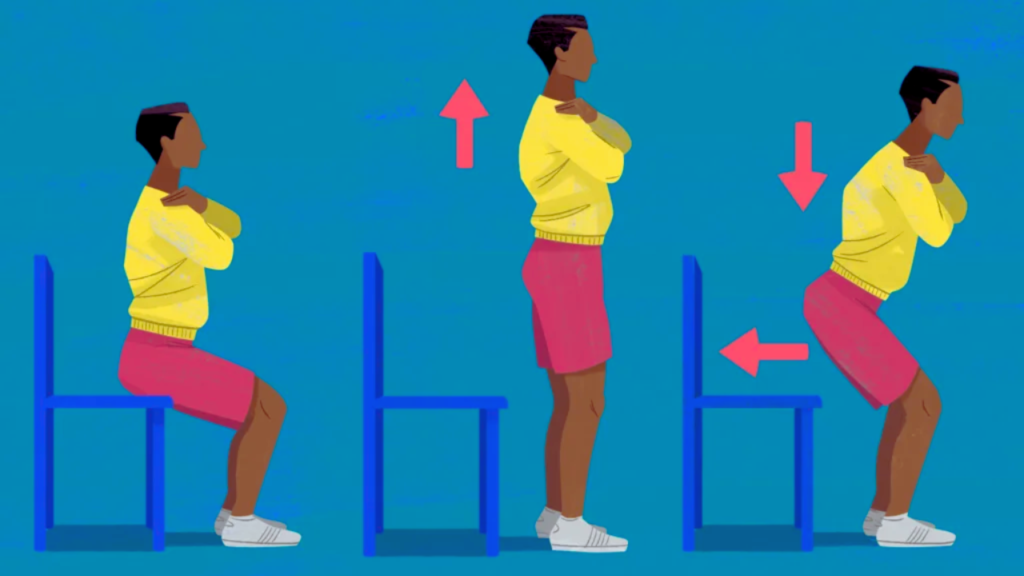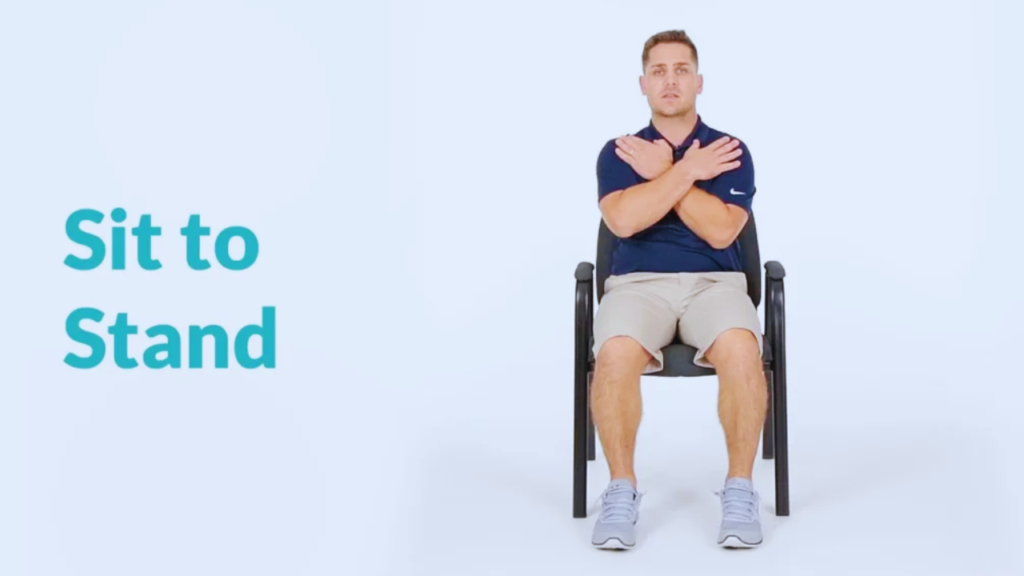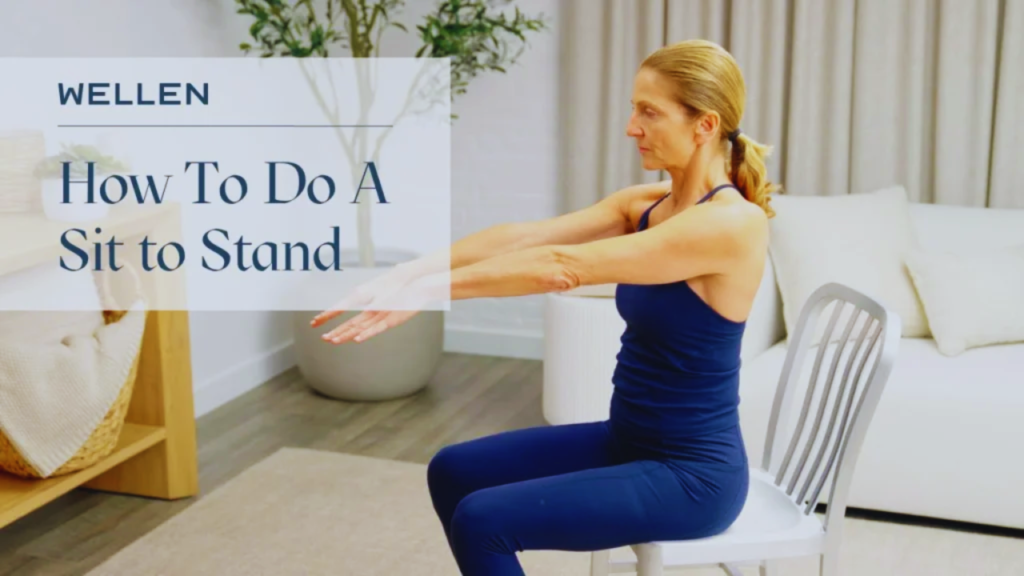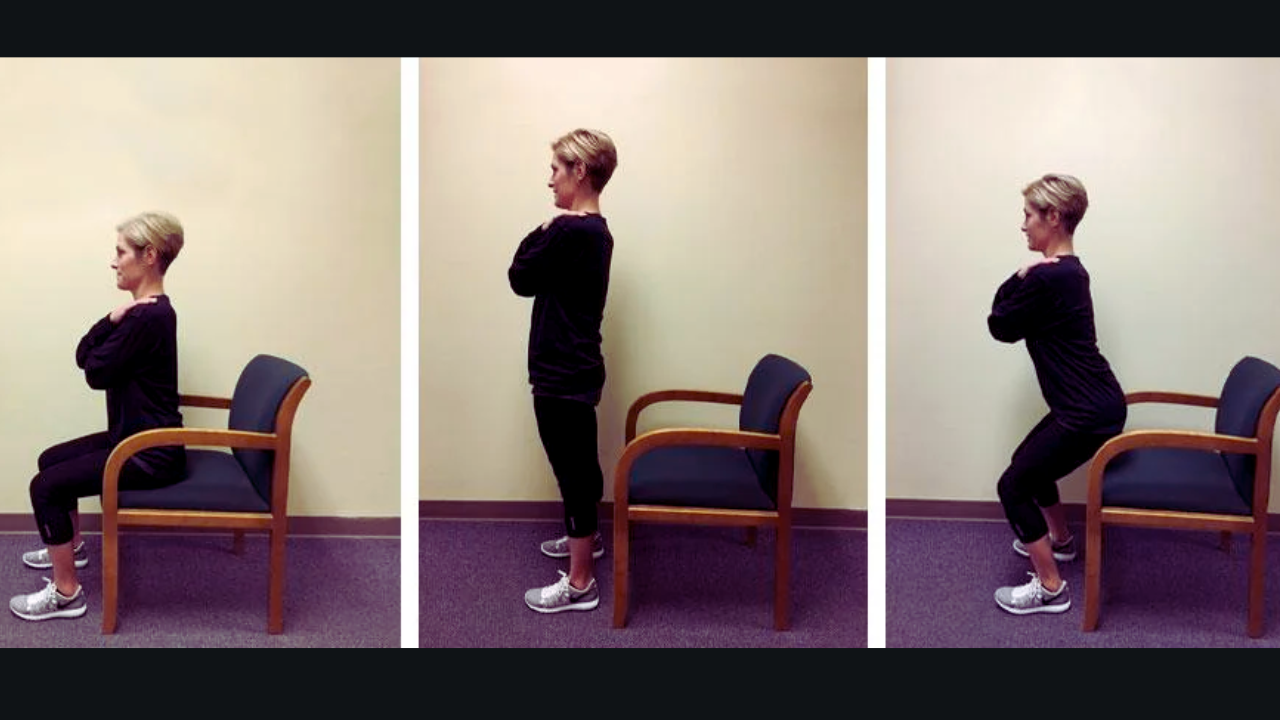
Do you find it difficult to stand up from a chair or feel unsteady when standing up from sitting? If so, incorporating the sit to stand exercise into your daily routine might be beneficial. This straightforward yet powerful exercise boosts mobility and strength in your lower body and enhances balance.
If you’re seeking a low-impact, gentle workout to begin your fitness journey, consider adding the sit-to-stand exercise to your routine. Furthermore, this exercise can be tailored to fit your fitness level. Therefore, don’t hesitate to start, even if you’re new to working out! Read on to see how sit-to-stand exercises can help you and how you can practice them at home.
Introduction to Sit To Stand Exercises

The sit-to-stand exercise, also called a chair stand or chair rise, requires you to sit and stand from a chair without using your hands. This exercise strengthens and balances the muscles fo your body that are needed for sitting and standing.
Incorporating sit to stand exercises into your routine can help you maintain independence in daily activities like using the bathroom, getting out of bed, or standing from a chair. It is also beneficial for those recovering from surgeries affecting mobility, such as hip or knee replacements, and for anyone aiming to strengthen their glutes, core, hips, or thighs.
Which Muscles Are Engaged During the Sit To Stand Exercise?
The sit-to-stand exercise boosts the strength of your core muscles, aiding stability in maintaining daily tasks like shifting your weight between feet, walking, or reaching for objects. Furthermore, it targets muscles in your glutes, thighs, and hips, including:
- Gluteus maximus: It’s the largest muscle in your buttocks. It mainly helps extend the hips, which is vital for standing up from a sitting position.
- Quadriceps: These are muscles found at the front side of your thigh. They help extend your knee. The quadriceps play a key role in pushing you up to stand and controlling your movement as you sit back down.
- Calves (soleus and gastrocnemius): These muscles play a key role in raising your heels and keeping your ankles steady when you push off the floor to stand up.
- Hamstrings: These muscles are found at the back side of your thigh. They team up with your quadriceps to manage the movements of sitting down and standing up. These muscles are essential for bending your knee and straightening your hip joint.
- Erector spinae: The erector spinae muscles run along your spine and play a crucial role in keeping you standing tall.
What Are The Advantages of Sit To Stand Exercises?
Incorporating low-impact, gentle exercises into your routine can boost your mobility and enhance your overall health. Let’s explore some key sit to stand exercise benefits:
- Greater Mobility: Sit-to-stand exercises promote flexibility and joint movement, allowing older adults to stay active and engaged in life.
- Enhanced Strength: Doing sit-to-stand movements can help you build and keep muscle strength, which is essential for everyday tasks such as climbing stairs and getting out of bed.
- Improved Posture: These exercises support good posture, which can ease back pain and boost overall spinal health.
- Independence: Sit-to-stand exercises for seniors can help them easily get up from a sofa or a chair. This can help older adults stay independent and lessen the need for help from others.
- Better Balance: Regularly practicing sit-to-stand exercises can improve your balance, helping to lower the risk of injuries and falls.
How to Properly Do A Sit-to-Stand Exercise?

Most chair exercises need very little area and can be done almost everywhere. Below are some simple steps to assist you in enjoying and benefiting from this exercise. Remember to check with your doctor before starting any new exercise routine.
- Sit in a sturdy chair, ideally one without wheels, and keep your feet shoulder-width apart.
- Slowly push through your feet to rise to a standing position.
- Carefully bend your knees and lower yourself back into the chair in a controlled manner.
- Rest for a moment and repeat as many times as you feel comfortable.
How Can You Make The Sit To Stand Exercise Easier?
To adjust the difficulty of sit-to-stand exercises, try the following tips:
- If the exercise feels too challenging, use a chair with strong armrests to help you stand up. In addition, you can use the armrests to gently lower yourself back into the chair. As you get stronger, try to rely less on your arms.
- Placing a firm pillow or cushion on the chair can also raise the seat height, making it easier to do the exercise.
- Opt for a taller chair to increase the seat height and make the sit-to-stand exercise easier.
How to Increase the Challenge of the Exercise as Your Strength Grows?
As your muscles and joints strengthen over time, some sit-to-stand exercises might start to feel easier. Below are a few ways to challenge yourself further. Always pay attention to your body and stop if you experience any discomfort or pain.
- Use a Lower Chair: When you stand up from a lower chair, it requires more effort from your joints and muscles, making the exercise tougher.
- Maintain The Standing Position: Try to maintain the standing position for as long as you comfortably can, keeping your core, lower back, and pelvic muscles engaged.
- Include Weights: For an extra challenge, try standing up while holding a water bottle or light dumbbells.
- Increase Repetitions: Consider doing more sit-to-stand repetitions to increase the challenge.
- Avoid Using Your Arms: Using your arms to push off the chair makes standing up easier. For a tougher workout, cross your arms over your chest while performing the exercise.
Safety Tips for Doing The Sit To Stand Exercise

The sit-to-stand exercise is great for keeping us healthy and active as we get older, but it is important to perform it safely to prevent injuries. Below are some important safety tips to remember.
- Start your exercise with a gentle warm-up to prepare your muscles.
- Check with your doctor before starting any new exercise routine.
- Inhale slowly via your nose and exhale slowly via your mouth.
- Listen to your body. If you feel dizziness, pain, or any unusual distress, stop exercising immediately and seek help from a doctor.
- Avoid holding your breath during strength exercises, as it can lead to unsafe changes in blood pressure.
- Do sit-to-stand workouts with a friend or under supervision to ensure safety.
- Stay hydrated by drinking water before, during, and after doing your exercise.
Closing Remarks
Building strength in your lower body plays a crucial role in moving independently and safely. The sit to stand exercise targets and strengthens your core and thigh muscles. If you have muscle or joint pain that makes movement difficult, this exercise might offer some relief.
However, always consult your healthcare provider before beginning any exercise program, particularly if you’ve recently had surgery.
